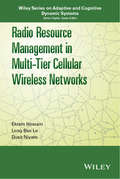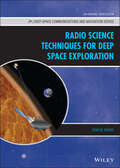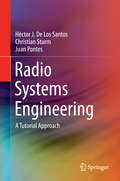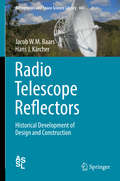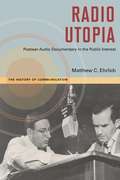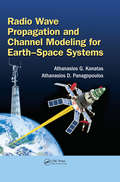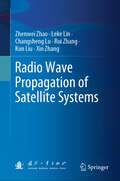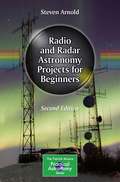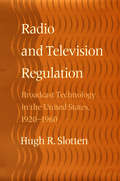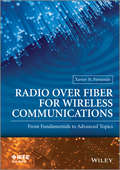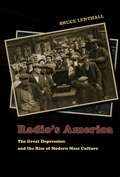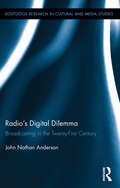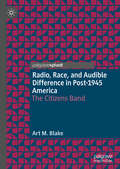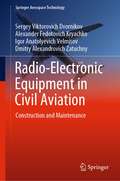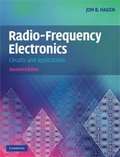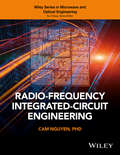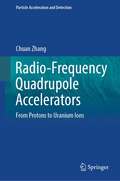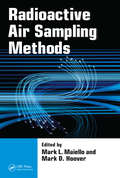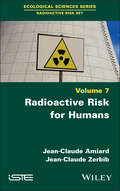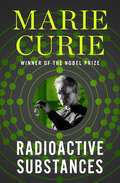- Table View
- List View
Radio Resource Management in Multi-Tier Cellular Wireless Networks
by Dusit Niyato Ekram Hossain Long Bao LeProviding an extensive overview of the radio resource management problem in femtocell networks, this invaluable book considers both code division multiple access femtocells and orthogonal frequency-division multiple access femtocells. In addition to incorporating current research on this topic, the book also covers technical challenges in femtocell deployment, provides readers with a variety of approaches to resource allocation and a comparison of their effectiveness, explains how to model various networks using Stochastic geometry and shot noise theory, and much more.
Radio Science Techniques for Deep Space Exploration (JPL Deep-Space Communications and Navigation Series)
by Sami W. AsmarExplore the development and state-of-the-art in deep space exploration using radio science techniques In Radio Science Techniques for Deep Space Exploration, accomplished NASA/JPL researcher and manager Sami Asmar delivers a multi-disciplinary exploration of the science, technology, engineering, mission operations, and signal processing relevant to deep space radio science. The book discusses basic principles before moving on to more advanced topics that include a wide variety of graphical illustrations and useful references to publications by experts in their respective fields. Complete explanations of changes in the characteristics of electromagnetic waves and the instrumentation and technology used in scientific experiments are examined. Radio Science Techniques for Deep Space Exploration offers answers to the question of how to explore the solar system with radio links and better understand the interior structures, atmospheres, rings, and surfaces of other planets. The author also includes: Thorough introductions to radio science techniques and systems needed to investigate planetary atmospheres, rings, and surfaces Comprehensive explorations of planetary gravity and interior structures, as well as relativistic and solar studies Practical discussions of instrumentation, technologies, and future directions in radio science techniques Perfect for students and professors of physics, astronomy, planetary science, aerospace engineering, and communications engineering, Radio Science Techniques for Deep Space Exploration will also earn a place in the libraries of engineers and scientists in the aerospace industry.
Radio Systems Engineering
by Héctor J. De Los Santos Christian Sturm Juan PontesThis book is intended for readers who already have knowledge of devices and circuits for radio-frequency (RF) and microwave communication and are ready to study the systems engineering-level aspects of modern radio communications systems. The authors provide a general overview of radio systems with their components, focusing on the analog parts of the system and their non-idealities. Based on the physical functionality of the various building blocks of a modern radio system, block parameters are derived, which allows the examination of their influence on the overall system performance. The discussion is complemented by tutorial exercises based on the Agilent SystemVue electronic system-level (ESL) design software. With these tutorials, readers gain practical experience with realistic design examples of radio transmission systems for communications and radar sensing. The tutorials cover state-of-the-art system standards and applications and consider the characteristics of typical radio-frequency hardware components. For all tutorials, a comprehensive description of the tasks, including some hints to the solutions, is provided. The readers are then able to perform these tasks independently. A complete set of simulation models and solutions to the tutorial exercises is given.
Radio Systems Engineering
by Steven W. EllingsonUsing a systems framework, this textbook provides a clear and comprehensive introduction to the performance, analysis and design of radio systems for students and practising engineers. Presented within a consistent framework, the first part of the book describes the fundamentals of the subject: propagation, noise, antennas and modulation. The analysis and design of radios, including RF circuit design and signal processing, is covered in the second half of the book. The former is presented with minimal involvement of Smith charts, enabling students to grasp the fundamentals more readily. Both traditional and software-defined/direct sampling technology are described, with pros and cons of each strategy explained. Numerous examples within the text involve realistic analysis and design activities, and emphasize how practical experiences may differ from theory or taught procedures. End-of-chapter problems are provided, as are a password-protected solutions manual and lecture slides to complete the teaching package for instructors.
Radio Telescope Reflectors: Historical Development of Design and Construction (Astrophysics and Space Science Library #447)
by Jacob W.M. Baars Hans J KärcherThis book demonstrates how progress in radio astronomy is intimately linked to the development of reflector antennas of increasing size and precision. The authors describe the design and construction of major radio telescopes as those in Dwingeloo, Jodrell Bank, Parkes, Effelsberg and Green Bank since 1950 up to the present as well as millimeter wavelength telescopes as the 30m MRT of IRAM in Spain, the 50m LMT in Mexico and the ALMA submillimeter instrument. The advances in methods of structural design and coping with environmental influences (wind, temperature, gravity) as well as application of new materials are explained in a non-mathematical, descriptive and graphical way along with the story of the telescopes. Emphasis is placed on the interplay between astronomical and electromagnetic requirements and structural, mechanical and control solutions. A chapter on management aspects of large telescope projects closes the book. The authors address a readership with interest in the progress of engineering solutions applied to the development of radio telescope reflectors and ground station antennas for satellite communication and space research. The book will also be of interest to historians of science and engineering with an inclination to astronomy.
Radio Utopia: Postwar Audio Documentary in the Public Interest
by Matthew C. EhrlichAs World War II drew to a close and radio news was popularized through overseas broadcasting, journalists and dramatists began to build upon the unprecedented success of war reporting on the radio by creating audio documentaries. Focusing particularly on the work of radio luminaries such as Edward R. Murrow, Fred Friendly, Norman Corwin, and Erik Barnouw, Radio Utopia: Postwar Audio Documentary in the Public Interest traces this crucial phase in American radio history, significant not only for its timing immediately before television, but also because it bridges the gap between the end of the World Wars and the beginning of the Cold War. Matthew C. Ehrlich closely examines the production of audio documentaries disseminated by major American commercial broadcast networks CBS, NBC, and ABC from 1945 to 1951. Audio documentary programs educated Americans about juvenile delinquency, slums, race relations, venereal disease, atomic energy, arms control, and other issues of public interest, but they typically stopped short of calling for radical change. Drawing on rare recordings and scripts, Ehrlich traces a crucial phase in the evolution of news documentary, as docudramas featuring actors were supplanted by reality-based programs that took advantage of new recording technology. Paralleling that shift from drama to realism was a shift in liberal thought from dreams of world peace to uneasy adjustments to a cold war mentality. Influenced by corporate competition and government regulations, radio programming reflected shifts in a range of political thought that included pacifism, liberalism, and McCarthyism. In showing how programming highlighted contradictions within journalism and documentary, Radio Utopia reveals radio's response to the political, economic, and cultural upheaval of the post-war era.
Radio Wave Propagation and Channel Modeling for Earth-Space Systems
by Athanasios G. Kanatas Athanasios D. PanagopoulosThe accurate design of earth–space systems requires a comprehensive understanding of the various propagation media and phenomena that differ depending on frequencies and types of applications. The choice of the relevant channel models is crucial in the design process and constitutes a key step in performance evaluation and testing of earth–space systems. The subject of this book is built around the two characteristic cases of satellite systems: fixed satellites and mobile satellite systems. <P><P>Radio Wave Propagation and Channel Modeling for Earth–Space Systems discusses the state of the art in channel modeling and characterization of next-generation fixed multiple-antennas and mobile satellite systems, as well as propagation phenomena and fade mitigation techniques. The frequencies of interest range from 100 MHz to 100 GHz (from VHF to W band), whereas the use of optical free-space communications is envisaged.Examining recent research advances in space-time tropospheric propagation fields and optical satellite communication channel models, the book covers land mobile multiple antennas satellite- issues and relative propagation campaigns and stratospheric channel models for various applications and frequencies. It also presents research and well-accepted satellite community results for land mobile satellite and tropospheric attenuation time-series single link and field synthesizers.The book examines aeronautical communications channel characteristics and modeling, relative radio wave propagation campaigns, and stratospheric channel model for various applications and frequencies. Propagation effects on satellite navigation systems and the corresponding models are also covered.
Radio Wave Propagation of Satellite Systems
by Xin Zhang Rui Zhang Kun Liu Zhenwei Zhao Leke Lin Changsheng LuThis book highlights the fundamental theories and prediction methods of radiowave propagation for the design, building, and operation of contemporary satellite systems. The primary objective of this book is to inquire into whether and how it is possible in a democracy to effectively decrease short-sighted policies. Although the commonplace expression “responsibility to future generations” has become firmly established in public and political vocabulary, its operational meaning and practice are not as well understood and have not yet been systematically evaluated. It still has not been successfully translated into viable ethical and theoretical concepts that can guide public policies and action. How can modes of governance and established priorities compatible with the well-being of future generations be created? This book identifies the conditions, and the obstacles, for such future-oriented governance. To meet the needs of diverse satellite applications, the book covers the main factors that affect radiowave propagation, including the clear-air effects, the hydrometeor effects, the ionospheric effects, the earth's surface reflection, and the local environmental effects. To enhance the prediction of radiowave propagation, the book elaborates on the characteristics of radio meteorological and ionospheric environments. It also summarizes research progress on the prediction methods of radio noise and interference coordination for satellite systems. The fade mitigation techniques and the propagation analysis of satellite system design are discussed. Providing a comprehensive summary of common practices and latest advances, the book is intended for researchers and engineers engaged in the study and practice of satellite systems, radio propagation, and its applications.
Radio and Radar Astronomy Projects for Beginners (The Patrick Moore Practical Astronomy Series)
by Steven ArnoldRadio and radar astronomy are powerful tools when studying the wonders of the universe, yet they tend to mystify amateur astronomers. This book provides a comprehensive introduction to newcomers, containing everything you need to start observing at radio wavelengths.Written by a mechanical engineer who has actually built and operated the tools described, the book contains a plethora of tested advice and practical resources. This revised edition of the original 2014 book Getting Started in Radio Astronomy provides a complete overview of the latest technology and research, including the newest models and equipment on the market as well as an entirely new section on radio astronomy with software-defined radios (SDRs). Four brand-new beginner projects are included, including bouncing a radar signal off the Moon, detecting the aurora, and tuning into the downlink radio used by astronauts aboard the ISS. Requiring no previous knowledge, no scary mathematics, and no expensive equipment, the book will serve as a fun and digestible reference for any level of astronomers hoping to expand their skills into the radio spectrum.
Radio and Television Regulation: Broadcast Technology in the United States, 1920-1960
by Hugh R. SlottenFrom AM radio to color television, broadcasting raised enormous practical and policy problems in the United States, especially in relation to the federal government's role in licensing and regulation. How did technological change, corporate interest, and political pressures bring about the world that station owners work within today (and that tuned-in consumers make profitable)? In Radio and Television Regulation, Hugh R. Slotten examines the choices that confronted federal agencies—first the Department of Commerce, then the Federal Radio Commission in 1927, and seven years later the Federal Communications Commission—and shows the impact of their decisions on developing technologies.Slotten analyzes the policy debates that emerged when the public implications of AM and FM radio and black-and-white and color television first became apparent. His discussion of the early years of radio examines powerful personalities—including navy secretary Josephus Daniels and commerce secretary Herbert Hoover—who maneuvered for government control of "the wireless." He then considers fierce competition among companies such as Westinghouse, GE, and RCA, which quickly grasped the commercial promise of radio and later of television and struggled for technological edge and market advantage. Analyzing the complex interplay of the factors forming public policy for radio and television broadcasting, and taking into account the ideological traditions that framed these controversies, Slotten sheds light on the rise of the regulatory state. In an epilogue he discusses his findings in terms of contemporary debates over high-resolution TV.
Radio in Revolution: Wireless Technology and State Power in Mexico, 1897–1938 (The Mexican Experience)
by J. Justin CastroLong before the Arab Spring and its use of social media demonstrated the potent intersection between technology and revolution, the Mexican Revolution employed wireless technology in the form of radiotelegraphy and radio broadcasting to alter the course of the revolution and influence how political leaders reconstituted the government.Radio in Revolution, an innovative study of early radio technologies and the Mexican Revolution, examines the foundational relationship between electronic wireless technologies, single-party rule, and authoritarian practices in Mexican media. J. Justin Castro bridges the Porfiriato and the Mexican Revolution, discussing the technological continuities and change that set the stage for Lázaro Cárdenas’s famous radio decree calling for the expropriation of foreign oil companies. Not only did the nascent development of radio technology represent a major component in government plans for nation and state building, its interplay with state power in Mexico also transformed it into a crucial component of public communication services, national cohesion, military operations, and intelligence gathering. Castro argues that the revolution had far-reaching ramifications for the development of radio and politics in Mexico and reveals how continued security concerns prompted the revolutionary victors to view radio as a threat even while they embraced it as an essential component of maintaining control.
Radio over Fiber for Wireless Communications: From Fundamentals to Advanced Topics (Wiley - IEEE)
by Xavier N. FernandoA comprehensive evaluation of Fi-Wi, enabling readers to design links using channel estimation and equalization algorithms This book provides a detailed study of radio over fiber (ROF) based wireless communication systems, otherwise called fiber wireless (Fi-Wi) systems. This is an emerging hot topic where the abundant bandwidth of optical fiber is directly combined with the flexibility and mobility of wireless networks to provide broadband connectivity. Its application is increasing because of the growing demand for broadband wireless services. In such a system the transmission of the radio signals over a fiber is an important task. This book provides substantial material on the radio over fiber part of the complete fiber-wireless system, including new research results on the compensation methods. The early chapters provide fundamental knowledge required for a non-expert engineering professional as well as senior/graduate level students to learn this topic from scratch. The latter part of the book covers advanced topics useful for researchers and senior students. Therefore, this book provides a comprehensive understanding of the system for readers who will gain enough knowledge to design Fi-Wi links of their own by learning how to develop Fi-Wi channel estimation and equalization algorithms. This concept is completely novel in current literature and has been patented by the author. Readers are expected to have a basic understanding of fiber optics and wireless communications to easily follow the book and to appreciate the concepts. Basics of the Fi-Wi system and signal processing approaches are clearly explained. It covers a multidisciplinary topic and acts as a bridge between optical and wireless communication domains. In the increasingly demanding telecommunications profession, engineers are expected to have knowledge in both optical and wireless communications and expected design combined/hybrid systems. Hence, the book is written in such a way that both optical and wireless professionals will be able to easily understand and perceive the concepts. follows a logical process from basic principles through to advanced topics, providing a wide range of interest for researchers, practicing engineers, students, and those required to build such networks explains detailed system design concepts and the limitations and advantages in each configuration, appealing to design engineers, and largely avoiding system specifics demonstrates the author’s exclusive patent, showing how to develop baseband signal processing algorithms for Fi-Wi systems, which is a key requirement for the successful deployment of Fi-Wi systems contains tables, numerical examples and case studies, facilitating a good quantitative understanding of the topic
Radio's America: The Great Depression and the Rise of Modern Mass Culture (Studies In Communication, Media, And Public Opinion Ser.)
by Bruce LenthallOrson Welles’s greatest breakthrough into the popular consciousness occurred in 1938, three years before Citizen Kane, when his War of the Worlds radio broadcast succeeded so spectacularly that terrified listeners believed they were hearing a genuine report of an alien invasion—a landmark in the history of radio’s powerful relationship with its audience. In Radio’s America, Bruce Lenthall documents the enormous impact radio had on the lives of Depression-era Americans and charts the formative years of our modern mass culture. Many Americans became alienated from their government and economy in the twentieth century, and Lenthall explains that radio’s appeal came from its capability to personalize an increasingly impersonal public arena. His depictions of such figures as proto-Fascist Charles Coughlin and medical quack John Brinkley offer penetrating insight into radio’s use as a persuasive tool, and Lenthall’s book is unique in its exploration of how ordinary Americans made radio a part of their lives. Television inherited radio’s cultural role, and as the voting tallies for American Idol attest, broadcasting continues to occupy a powerfully intimate place in American life. Radio’s America reveals how the connections between power and mass media began.
Radio's Digital Dilemma: Broadcasting in the Twenty-First Century (Routledge Research in Cultural and Media Studies #60)
by John Nathan AndersonRadio's Digital Dilemma is the first comprehensive analysis of the United States’ digital radio transition, chronicling the technological and policy development of the HD Radio broadcast standard. A story laced with anxiety, ignorance, and hubris, the evolution of HD Radio pitted the nation’s largest commercial and public broadcasters against the rest of the radio industry and the listening public in a pitched battle over defining the digital future of the medium. The Federal Communications Commission has elected to put its faith in "marketplace forces" to govern radio’s digital transition, but this has not been a winning strategy: a dozen years from its rollout, the state of HD Radio is one of dangerous malaise, especially as newer digital audio distribution technologies fundamentally redefine the public identity of "radio" itself. Ultimately, Radio’s Digital Dilemma is a cautionary tale about the overarching influence of economics on contemporary media policymaking, to the detriment of notions such as public ownership and access to the airwaves—and a call for media scholars and reformers to engage in the continuing struggle of radio’s digital transition in hopes of reclaiming these important principles.
Radio, Race, and Audible Difference in Post-1945 America: The Citizens Band
by Art M. BlakeIn the second half of the twentieth century, new sounds began to reverberate across the United States. The voices of African-Americans as well as of women, Latinx, queer, and trans people broke through in social movements, street protests, and in media stories of political and social disruption. Postwar America literally sounded different. This book argues that new technologies and new mobilities sharpened American attention to these audibly coded identities, on the radio, on the streets and highways, in new music, and on television. Covering the Puerto Rican migration to New York in the 1950s, the varying uses of CB radio by white and African American citizens in the 1970s, and the emergence of audible queerness, Art M. Blake attunes us to the sounds of race, mobility, and audible difference. As he argues, marginalized groups disrupted the postwar machine age by using new media technologies to make themselves heard.
Radio-Electronic Equipment in Civil Aviation: Construction and Maintenance (Springer Aerospace Technology)
by Dmitry Alexandrovich Zatuchny Sergey Viktorovich Dvornikov Alexander Fedotovich Kryachko Igor Anatolyevich VelmisovThis book presents the maintenance of radio equipment and the principles of operation of various radio receiving devices in civil aviation. The main feature of this book is the fact that it covers almost all types of radio receivers currently used in radar, communication and navigation equipment of civil aviation. Special attention is paid to ensuring the sensitivity of the receiver, as well as noise suppression under various conditions. A detailed description of the set of methods for receiving signals, especially in the case of frequency telegraphy is presented. This book provides a detailed description of specific methods of signal processing with frequency modulation—the so-called threshold-lowering reception methods based on reducing the bandwidth to the detector part of the private reception path in combination with the principle of negative feedback. The material presented in this book follows a logical sequence with a large amount of illustrations.
Radio-Frequency Electronics: Circuits and Applications
by Jon B. HagenThis second, updated edition of the best-selling Radio-Frequency Electronics introduces the basic concepts and key circuits of radio-frequency systems. It covers the fundamental principles applying to all radio devices, from wireless single-chip data transceivers to high-power broadcast transmitters. This new edition is extensively revised and expanded throughout, including additional chapters on radar, digital modulation, GPS navigation, and S-parameter circuit analysis. New worked examples and end-of-chapter problems are included to aid and test understanding of the topics covered, as well as numerous extra figures to provide a visual aid to learning. Key topics covered include filters, amplifiers, oscillators, modulators, low-noise amplifiers, phase lock loops, transformers, waveguides, and antennas. Assuming no prior knowledge of radio electronics, this is a perfect introduction to the subject. It is an ideal textbook for junior or senior courses in electrical engineering, as well as an invaluable reference for professional engineers in this area.
Radio-Frequency Heating in Food Processing: Principles and Applications (Electro-Technologies for Food Processing Series)
by Juming Tang George B. Awuah Hosahalli S. RamaswamyThis book covers the fundamental science and engineering principles governing radio-frequency (RF) applications and provides a solid understanding of industrial RF unit design options, challenges, and opportunities for development. It explains the similarities, differences, advantages, and limitations of RF and microwave heating; discusses dielectric and thermo-physical properties; provides practical perspectives on industrial RF units used in manufacturing food products; examines RF-heating effects on microorganisms, enzymes, and food quality attributes; and explores RF-heating applications beyond food processing, such as waste treatment and counterfeit prevention.
Radio-Frequency Integrated-Circuit Engineering
by Cam NguyenRadio-Frequency Integrated-Circuit Engineering addresses the theory, analysis and design of passive and active RFIC's using Si-based CMOS and Bi-CMOS technologies, and other non-silicon based technologies. The materials covered are self-contained and presented in such detail that allows readers with only undergraduate electrical engineering knowledge in EM, RF, and circuits to understand and design RFICs. Organized into sixteen chapters, blending analog and microwave engineering, Radio-Frequency Integrated-Circuit Engineering emphasizes the microwave engineering approach for RFICs. * Provides essential knowledge in EM and microwave engineering, passive and active RFICs, RFIC analysis and design techniques, and RF systems vital for RFIC students and engineers * Blends analog and microwave engineering approaches for RFIC design at high frequencies * Includes problems at the end of each chapter
Radio-Frequency Quadrupole Accelerators: From Protons to Uranium Ions (Particle Acceleration and Detection)
by Chuan ZhangThis book guides readers into the realm of particle accelerators, which have served as indispensable tools for fundamental research, energy development, medical therapy, industrial applications, national security, etc., since 1924. Towards a new generation of high power proton and ion accelerators, challenges often come from space charge effects, which are most pronounced in low-velocity beams. This book focuses on Radio-Frequency Quadrupole (RFQ) accelerators, one of the most popular front-end structures for accelerator facilities, and their beam physics. Uncovering the limitations of the classic design methods, novel approaches to achieve efficient RFQ accelerators with high beam quality will be presented. In addition, new ideas for possible future developments, such as how to realize long RFQs with high performance and how RFQs can be applied for much higher beam-velocities to shorten large-scale accelerators, will be introduced. To provide a general overview of the research and development of RFQs accelerating particle species from protons to uranium ions, this book uses over 10 real examples developed or proposed in the twenty-first century for various facilities of different dimensions (from large scale e.g. a collider to small scale e.g. university experimental setups). With its rich content and comprehensive scope, this book is an invaluable reference for researchers and graduate students interested in RFQ accelerators and the intricacies of space charge physics in low-velocity beams.
Radioactive Air Sampling Methods
by Mark L. Maiello Mark D. HooverAlthough the field of radioactive air sampling has matured and evolved over decades, it has lacked a single resource that assimilates technical and background information on its many facets. Edited by experts and with contributions from top practitioners and researchers, Radioactive Air Sampling Methods provides authoritative guidanc
Radioactive Contamination of the Tokyo Metropolitan Area: Five Years after the Fukushima Nuclear Accident
by Hideo YamazakiThis book presents the 5-year monitoring of radioactive contamination in the Tokyo metropolitan area due to the Fukushima accident, covering radiation monitoring of soil, litter, river, water, seawater, aquatic sediments, fish and shellfish, and plants in urban areas. Based on spatial and temporal data, it evaluates the environmental radiation contamination of the Tokyo metropolitan following the first nuclear accident affecting an urban area since Chernobyl. Since little is known about the contamination in Kiev city, this data is particularly valuable, offering insights into the dynamics of radioactive contamination in metropolitan areas, which are of interest in relation to the behavior of radionuclides resulting not only from nuclear accidents but also from nuclear terrorism? As such, this book will be appeal to nuclear and radiation experts, environmental administration professionals and specialists in environmental protection groups, as well as student and academics in the related fields.
Radioactive Pollutant: Sources, Issues and Remediation (Environmental Science and Engineering)
by Nitish KumarThis book sheds light on the global environmental issue and proposes solutions to contamination through multi-disciplinary approaches. Radioactivity occurs naturally. Ionizing radiation has always been a threat to humans and all other living things on earth. While the average global readings could be a suitable benchmark for what must be deemed "normal," the natural level of radiation exposure varies by around an order of magnitude for different locations of the earth. Regardless of whether this degree of radiation exposure qualifies as innocuous, it cannot be avoided because some diseases may be caused by exposure to naturally occurring radiation. As a result, these natural exposures serve as the foundation for and comparison point for radiation protection principles such as dose limits or limitations. The majority of the ionizing radiation that the world's population is exposed to comes from natural sources The public receives maximum doses from nuclear sites that are now in normal operation those are typically two orders of magnitude below the background radiation. In industrialized nations, medical uses of radioactivity and ionizing radiation result in mean doses that are comparable to those from natural radiation, but individual doses vary greatly. This edited book brings together a diverse group of researchers to address the challenges posed by global mass poisoning caused by radionuclides. This book contains three sections. First section describes the different sources of radioactive pollutant in the environment. Second section explains the health risk linked to radioactive pollutant. Third section addresses sustainable remediation strategies of radioactive waste and the potential applications of recent biological technology in providing solutions. This book is a valuable resource to students, academics, researchers, and environmental professionals doing field work on management of radioactive waste throughout the world.
Radioactive Risk for Humans (ISTE Consignment)
by Jean-Claude Amiard Jean-Claude ZerbibOnce scientists discovered radioactivity, they soon recognized its dangers. However, the assessment of radioactive risk to humans is still the subject of heated debate. In this book, the authors present a summary of past and recent scientific work on estimating radioactivity in the anthroposphere and the radioactive contamination of human beings. They describe the various sources of exposure to ionizing radiation (external, internal and dietary) and estimate the irradiation doses suffered by humans under various conditions (both naturally occurring for the general public and professionals, and from accidents). The harmful effects of ionizing radiation at various biological levels (molecular, cellular and tissue) and health effects at the individual level are also discussed. Particular focus will be placed on radiation-induced occupational illnesses. The relationship between doses of ionizing radiation and its harmful effects is discussed with reference to high, medium and low doses. The controversies on this subject are outlined, and international and French regulatory values are provided. Finally, an estimate of the radioactive risk for humans is suggested.
Radioactive Substances: Thesis Presented To The Faculte Des Sciences De Paris (classic Reprint)
by Marie CurieThe pioneering scientist&’s doctoral thesis on radioactivity that won her the 1903 Nobel Prize in Physics. In 1896, Antoine Henri Becquerel discovered the first evidence of radioactivity. Inspired by the physicist&’s work, Marie Curie began investigating this phenomenon further with the help of her husband, Pierre. For four years, the couple researched various minerals and substances for radioactivity, a term she coined. In Radioactive Substances,Curie outlines with great detail her painstaking research and discoveries, which include the elements radium and polonium. Due to their breakthroughs, Marie and Pierre were awarded the Nobel Prize in Physics in 1903, the first of two for Marie.
